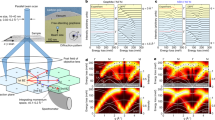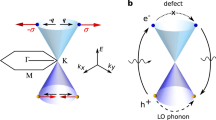Abstract
We have studied the transmission of 5 keV protons through graphene. Proton dynamics was modeled by classical theory. Proton trajectories define a mapping of the set of initial proton positions to the set of scattering angles. Singularities of the Jacobian associated with the introduced mapping form curves known as the rainbow lines. The differential cross section is infinite along the rainbow lines, making the proton count significantly larger along the rainbow pattern. Hence, rainbows dominantly determine the shape and size of the angular distribution of transmitted protons. It was found that reorientation of the graphene with respect to the incident beam direction and deformation of the graphene crystal lattice induce the transformation of the proton rainbow pattern. We thoroughly studied the morphological properties of the proton rainbow pattern. It was shown that angular distribution and the corresponding rainbow pattern could be used to determine the covariance matrix of atomic thermal displacements and to characterize point defects present in graphene.
Graphical abstract

Red arrows illustrate the incident and transmitted proton beams, respectively. From left to right are presented perfect graphene with isotropic thermal atomic motion, perfect graphene with anisotropic atomic thermal vibrations, and defective graphene with isotropic thermal vibrations of atoms. Blue surfaces are illustrations of the interaction potential isosurfaces in the vicinity of individual carbon atoms. Black spheres are carbon atoms. Corresponding angular distributions of the transmitted proton beams are presented below. The associated rectangular insets depict enlarged views of the central parts of corresponding distributions. Angular yields are expressed in the logarithmic scale and presented by the associated colormap







Similar content being viewed by others
Data Availability Statement
This manuscript has no associated data or the data will not be deposited. The datasets generated during and/or analyzed during the current study are available from the corresponding author on reasonable request.
References
J.A. Venables, G.D.T. Spiller, M. Hanbucken, Nucleation and growth of thin films. Rep. Prog. Phys. 47, 399 (1984). https://doi.org/10.1088/0034-4885/47/4/002
J.W. Evans, P.A. Thiel, M.C. Bartelt, Morphological evolution during epitaxial thin film growth Formation of 2D islands and 3D mounds. Surf. Sci. Rep. 61(1), 1–128 (2006). https://doi.org/10.1016/j.surfrep.2005.08.004
K.S. Novoselov et al., Electric field effect in atomically thin carbon films. Science 306(5696), 666–669 (2004). https://doi.org/10.1126/science.1102896
K. Cao, S. Feng, Y. Han et al., Elastic straining of free-standing monolayer graphene. Nat. Commun. 11, 1 (2020). https://doi.org/10.1038/s41467-019-14130-0
M.I. Katsnelson, Graphene: Carbon in Two Dimensions. Cambridge University Press (2012). https://doi.org/10.1017/CBO9781139031080
G. Fiori et al., Electronics based on two-dimensional materials. Nat. Nanotechnol. 9, 1063 (2014). https://doi.org/10.1038/nnano.2014.283
N. Mohanty, V. Berry, Graphene-based single-bacterium resolution biodevice and DNA-transistor: interfacing graphene-derivatives with nano and micro scale biocomponents. Nano Lett. 8(12), 4469–4476 (2008). https://doi.org/10.1021/nl802412n
T. Yiang et al., Furin-mediated sequential delivery of anticancer cytokine and small-molecule drug shuttled by graphene. Adv. Mater. 27(6), 1021–1028 (2014). https://doi.org/10.1002/adma.201404498
J.C. Meyer, A.K. Geim, M.I. Katsnelson, K.S. Novoselov, T.J. Booth, S. Roth, The structure of suspended graphene sheets. Nature 446, 7131 (2007). https://doi.org/10.1038/nature05545
C.S. Allen, E. Liberti, J.S. Kim, Q. Xu, Y. Fan, K. He, A.W. Robertson, H.W. Zandbergen, J.H. Warner, A.I. Kirkland, Temperature dependence of atomic vibrations in mono-layer graphene. J. Appl. Phys. 118, 7 (2015). https://doi.org/10.1063/1.4928324
A. Fasolino, J.H. Los, M.I. Katsnelson, Intrinsic ripples in graphene. Nat. Mater. 6, 858–861 (2007). https://doi.org/10.1038/nmat2011
W. Tiao et al., A review on lattice defects in graphene: types, generation. Effects and regulation. Micromachines 8, 5 (2017). https://doi.org/10.3390/mi8050163
F. Banhart, J. Kotakoski, A.V. Krasheninnikov, Structural defects in graphene. ACS Nano 5(1), 26–41 (2011). https://doi.org/10.1021/nn102598m
P.T. Araujo, M. Terrones, M.S. Dresselhaus, Defects and impurities in graphene-like materials. Mater. Today 15(3), 98–109 (2012). https://doi.org/10.1016/S1369-7021(12)70045-7
J. Jiang et al. Defect Engineering in 2D Materials: Precise Manipulation and Improved Functionalities. Research (2019). https://doi.org/10.34133/2019/4641739
S. Li, M. Liu, X. Qiu, Scanning probe microscopy of topological structure induced electronic states of graphene. Small Methods 4, 3 (2020). https://doi.org/10.1002/smtd.201900683
H.T. Chin et al., Impact of growth rate on graphene lattice-defect formation within a single crystalline domain. Sci. Rep. 8, 4046 (2018). https://doi.org/10.1038/s41598-018-22512-5
M. Ziatdinov et al., Building and exploring libraries of atomic defects in graphene: scanning transmission electron and scanning tunneling microscopy study. Sci. Adv. 5, 9 (2019). https://doi.org/10.1126/sciadv.aaw8989
B. Zheng, G.X. Gu, Machine learning-based detection of graphene defects with atomic precision. Nano-Micro Lett. 12, 181 (2020). https://doi.org/10.1007/s40820-020-00519-w
O.S. Ovchinnikov et al., Detection of defects in atomic-resolution images of materials using cycle analysis. Struct. Chem. Imaging 6, 3 (2020). https://doi.org/10.1186/s40679-020-00070-x
N. Nešković, Rainbow effect in ion channeling. Phys. Rev. B 33, 6030 (1986)
H.F. Krause, S. Datz, P.F. Dittner, J. Gomez del Campo, P.D. Miller, C.D. Moak, N. Nešković, P.L. Pepmiller, Rainbow effect in axial ion channeling. Phys. Rev. B 33, 6036 (1986)
S. Petrović, N. Nešković, M. Ćosić, M. Motapothula, M.B.H. Breese, Proton–silicon interaction potential extracted from high-resolution measurements of crystal rainbows. Nucl. Instrum. Methods Phys. Res. B 360, 23–29 (2015)
S. Petrović, I. Telečki, D. Borka, N. Nešković, Angular distributions of high energy protons channeled in long (10, 10) single-wall carbon nanotubes. Nucl. Instrum. Methods Phys. Res. B 267(14), 2365–2368 (2009)
M. Ćosić, S. Petrović, S. Bellucci, Rainbow channeling of protons in very short carbon nanotubes with aligned stonewales defects. Nucl. Instrum. Methods Phys. Res. B 367, 37–45 (2016)
J.F. Ziegler, J.P. Biersack, U. Littmark, The Stopping and Range of Ions in Solids (Pergamon Press, New York, 1985). https://doi.org/10.1007/978-1-4615-8103-1_3
G. Moliere, Theorie der Streuung schneller geladener Teilchen I: einzelstreuung am abgeschirmten Coulomb-Feld. Z. Naturforsch 2a, 133–145 (1947)
P. Doyle, P. Turner, Relativistic Hartree-Fock X-ray and electron scattering factors. Acta Cryst. A 24, 390–397 (1968). https://doi.org/10.1107/S0567739468000756
X. Artru, S.P. Fomin, N.F. Shulga, K.A. Ispirian, N.K. Zhevago, Carbon nanotubes and fullerites in high-energy and X-ray physics. Phys. Rep. 412(2), 89–189 (2005)
B.R. Appleton, C. Erginsoy, W.M. Gibson, Channeling effects in the energy loss of 3–11-mev protons in silicon and germanium single crystals. Phys. Rev. 161, 330 (1967). https://doi.org/10.1103/PhysRev.161.330
M. Ćosić, M. Hadžijojić, S. Petrović, R. Rymzhanov, S. Bellucci, Investigation of the graphene thermal motion by rainbow Scattering. Carbon 145, 161–174 (2019). https://doi.org/10.1016/j.carbon.2019.01.020
E. Gruber, Ultrafast electronic response of graphene to a strong and localized electric field. Nat. Commun. 7, 13948 (2016). https://doi.org/10.1038/ncomms13948
L.D. Landau, E.M. Lifshitz, Mechanics. Butterworth-Heinemann (1976). https://doi.org/10.1016/C2009-0-25569-3
S. Petrović, N. Starčević, M. Ćosić, Universal axial (001) rainbow channeling interaction potential. Nucl. Inst. Methods Phys. Res. B 447, 79 (2019). https://doi.org/10.1016/j.nimb.2019.03.050
N. Starčević, S. Petrović, Crystal rainbow channeling potential for (001) and (111) cubic crystallographic crystals. Nucl. Inst. Methods Phys. Res. B 499, 39–45 (2021). https://doi.org/10.1016/j.nimb.2021.03.004
M. Ćosić, S. Petrović, N. Nesković, The forward rainbow scattering of low energy protons by a graphene sheet. Nucl. Instr. Methods Phys. Res. B 422, 54 (2018). https://doi.org/10.1016/j.nimb.2018.02.028
R. Wilhelm, E. Gruber, R. Ritter, R. Heller, S. Facsko, F. Aumayr, Charge exchange and energy loss of slow highly charged ions in 1 nm thick carbon nanomembranes. Phys. Rev. Lett. 112, 153201 (2014). https://doi.org/10.1103/PhysRevLett.112.153201
D. Jalabert, Real space structural analysis using 3D MEIS spectra from a toroidal electrostatic analyzer with 2D detector. Nucl. Instrum. Methods Phys. Res. B 270, 19 (2012). https://doi.org/10.1016/j.nimb.2011.09.025
R. Tromp, M. Copel, M. Reuter, M.H. von Hoegen, J. Speidell, R. Koudijs, MH v. Hoegen, J. Speidell, and R. Koudijs. Rev. Sci. Instrum. 62, 2679 (1991). https://doi.org/10.1063/1.1142199
R. Tromp, H. Kersten, E. Granneman, F. Saris, Granneman E. F, W. Saris, RJ Koudijs and WJ Kilsdonk. Nucl. Instrum. Methods Phys. Res. B 4, 155 (1984). https://doi.org/10.1016/0168-583X(84)90055-7
R. Smeenk, H.K.R.M. Tromp, A. Boerboom, F. Saris, Nucl. Instrum. Methods Phys. Res. 195, 581 (1982)
M. Ćosić, M. Hadžijojić, S. Petrović, R. Rymzhanov, Morphological study of the rainbow scattering of protons by graphene. Chaos 31, 093115 (2021). https://doi.org/10.1063/5.0059093
M. Hadžijojić, M. Ćosić, R. Rymzhanov, Morphological analysis of the rainbow patterns created by point defects of graphene. J. Phys. Chem. C 125(38), 21030–21043 (2021). https://doi.org/10.1021/acs.jpcc.1c05971
Acknowledgements
Authors acknowledge the support of the Ministry of Science, Technological Development and Innovation of Serbia under the contract No. 451-03-47/2023-01/200017.
Author information
Authors and Affiliations
Contributions
M. H. and M. Ć. developed the theoretical framework and performed all calculations. The investigation was supervised by M. Ć, and M. H. wrote the first draft of the manuscript. Both authors commented on the manuscript and approved its final version.
Corresponding author
Ethics declarations
Conflict of interest
The authors declare that they have no known competing financial interests or personal relationships that could have appeared to influence the work reported in this paper.
Additional information
T.I.: Physics of Ionized Gases and Spectroscopy of Isolated Complex Systems: Fundamentals and Applications. Guest editors: Bratislav Obradović, Jovan Cvetić, Dragana Ilić, Vladimir Srećković and Sylwia Ptasinska.
Rights and permissions
Springer Nature or its licensor (e.g. a society or other partner) holds exclusive rights to this article under a publishing agreement with the author(s) or other rightsholder(s); author self-archiving of the accepted manuscript version of this article is solely governed by the terms of such publishing agreement and applicable law.
About this article
Cite this article
Hadžijojić, M., Ćosić, M. Study of graphene by proton rainbow scattering. Eur. Phys. J. D 77, 86 (2023). https://doi.org/10.1140/epjd/s10053-023-00664-y
Received:
Accepted:
Published:
DOI: https://doi.org/10.1140/epjd/s10053-023-00664-y




